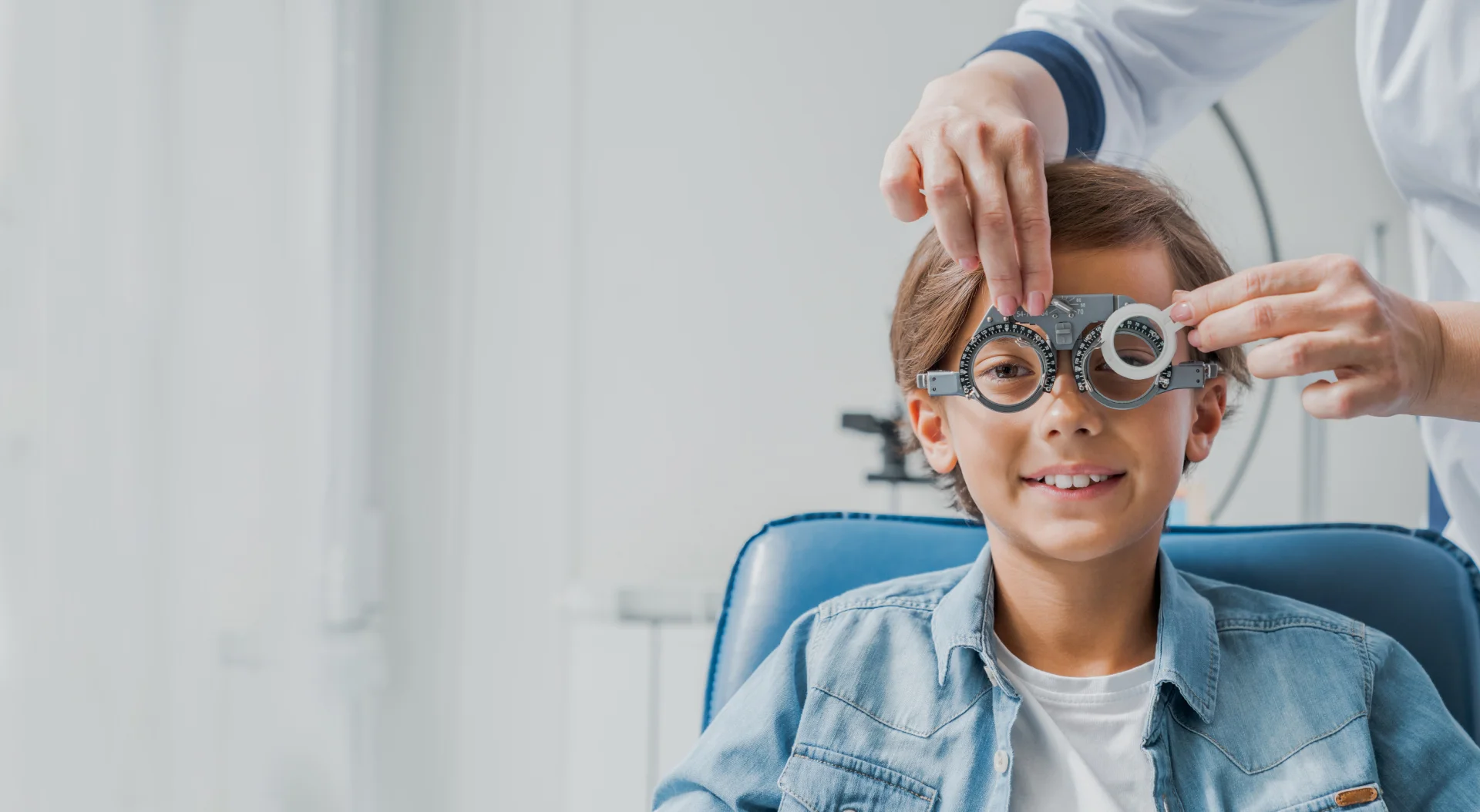
Amblyopia
All info about amblyopia
What is amblyopia?
The term “amblyopia” is derived from the Greek word meaning “dull eye.” It signifies reduced visual acuity of one eye without a measurable organic or neuronal cause. As many as 5% of all children in Germany suffer from this form of visual impairment.
Here is the problem: In healthy children, the images of the outside world that both eyes see are translated into nerve impulses that are sent to the brain where they are processed evenly and simultaneously, allowing for 3D “stereovision.” However, this 3D vision works only if the brain receives high-quality images from both eyes. In children with amblyopia, the images from the two eyes do not match because one eye is weaker (the “lazy” eye) due to a clouding of the lens (creating blurry imges), a focusing power that is much different from that of the other eye (unsharp images), or because of the child’s crossed-eye (producing double-images). The mismatch can be spatial when one eye is shifted to the side (as in crossed eyes), it can be mismatched in brightness or sharpness (as in congenital cataract), or it can be mismatched in temporal processing (when information from one eye arrives to the brain after information from the other eye arrives).
Because this mismatch is too difficult for the brain to handle, the brain ignores the information it receives from the lazy eye and only processes visual signals from the “stronger” eye. The visual pathway from the neglected eye then becomes less active and fails to properly develop. While the connection to the brain is there, the synapses do not get activated, as if they were “switched off” by the brain.

“The optimization of residual vision is a holistic complement to ophthalmological care such as eye drops or surgeries. We continue where ophthalmology stops. We combine conventional medical science with new findings from modern brain research and traditional medicine methods.”
The causes of amblyopia
In most cases, amblyopia affects only one eye. The weaker eye itself is healthy, but the brain does not properly process the images that it receives from that eye. The underlying problem is that the brain receives different images from each eye, and to reduce confusion, it switches off the processing of nerve signals from the “lazy” eye. In a normally developed child, two nearly identical images are received and merged to produce “binocular” or 3D vision. In a child with amblyopia, one eye may be highly short-sighted, one eye may be cloudy for some reason (for example, congenital cataract), or the eyes do not move together in parallel (as in strabismus, or “crossed eyes”). To reduce or eliminate this confusion, the brain directs its attention (or neuronal energy) only to the information that arrives from the good eye — which becomes the stronger (healthy) one, outcompeting the weak eye. Then the visual nerve cells that process information from the “neglected” eye are not stimulated (used) enough, and this “nonuse” prevents the proper development of the eye´s connections within the brain. While the connections may be anatomically present, their synapses remain silent.
How can I tell if my child has amblyopia?
Amblyopia can be caused by different problems and can show different symptoms. It is especially difficult for parents to recognize amblyopia in young children who are unable to notice the problem themselves or cannot (yet) tell their parents about it. One test a parent can do is to have the child look with each eye separately and ask them if there is any difference in what they see, for example, if what they see with one eye is weaker or blurrier than what they see with the other eye. In any event, once a problem has been recognized, regular checkups are important, including those with an ophthalmologist.
recognizing objects, which could indicate they are amblyopic. At later stages of childhood, problems with writing or reading often occur, and they may not be recognized until the child goes to school and is asked to sit in the front row of the classroom because of their poor vision. Children with amblyopia may also have problems with hand-eye coordination. Because only one eye does the job of seeing the world, spatial (3D) vision is typically impaired in amblyopia.
It is relatively common for amblyopia to go unrecognized in childhood because children quickly become accustomed to seeing sharply with only one eye and they have never learned what 3D vision is. What´s more, other people often do not recognized that the child does not see properly, because the eye itself looks normal on the outside. Therefore, the problem is often not noticed by the parents or the child’s peers.
What is strabismic amblyopia?
Strabismus describes a situation where the two eyes are not aligned, that is, they do not look in the same direction. This is the main problem with children who are cross-eyed. In children with strabismus, the brain receives different information from each eye, and this leads to double vision. The brain does not know which eye to rely on and is unable to form an overall (binocular or 3D) image. It recognizes one image as correct and ignores the image from the crossed-eye. Because the double image is confusing, the brain gradually switches off neural processing of visual signals from that eye. Consequently, the eye is no longer used and becomes “lazy”, resulting in fuzzy or blurry vision in that eye. Because crossed eyes are easily noticed by others, parents, teachers, and doctors are alerted to attend to this problem.
What is refractive amblyopia?
Refractive amblyopia is when the images received by the right and left eyes do not have the same focus — for example, if one eye is longer than the other — and the brain processes information only from the eye with the clearest image. For example, the left eye might be nearsighted while the right eye is farsighted. Because the brain has difficulty merging the images from both eyes, it does not pay attention to the problematic eye and ignores its visual signals. As a result of this “nonuse”, the synapses within its visual pathway become weak, though the connection is still there. Unlike the condition of crossed eyes, refractive amblyopia cannot be easily noticed by children because they have always had this condition and do not know that it is abnormal. It can also not be noticed easily by others such as parents or teachers, because the eyes are not crossed and there are no visible changes to the weak eye. The situation is similar when one eye has congenital cataract (clouding of the eye´s lens).
How is amblyopia treated?
If an ophthalmologist or orthoptist diagnoses amblyopia, they will also provide information about treatment options. The best time to treat amblyopia is during childhood. The development of normal vision is usually completed in the early teenage years, after which — at least according to traditional teachings of conventional medicine — amblyopia cannot be treated. Especially during childhood, the current standard of care is occlusion therapy, which involves using an eye patch to cover one eye. The patch masks the healthy eye to force the brain to process signals from the weak eye. The doctrine is that this treatment only works in childhood. However, recent research shows that such a therapy is also effective in adulthood because the brain maintains adaptability (plasticity) in adulthood.
For strabismus, surgery of the eye muscles to align the eyes also may be helpful. There are also corrective prism-like eyeglasses that can shift the visual field enough to counteract the deviation of the strabismic eye. And new methods are being developed with special glasses or virtual reality goggles that train both eyes equally by reducing the activity of the strong eye and increasing the activity of the weak eye, so both are balanced again (usually for the first time).
How can SAVIR therapy help with amblyopia?
SAVIR therapy uses an alternating current treatment that improves blood flow to the retina and brain while stimulating brain cells to fire rhythmic signals to induce “plasticity.” In doing so, it helps to reorganize the function of neurons in the retina and brain by forcing nerve cells to fire in synchrony while also improving blood flow. This then enhances the function of the brain networks by strengthening the weak eye. This has proven to be very effective in the case of amblyopia, where the brain cannot properly process the images sent by both eyes.
Worldwide Unique, Holistic Therapy for Optic Nerve Damage
0
Years of Research Leadership
Years of Experience and Success in Treating Patients
